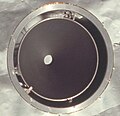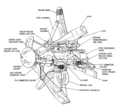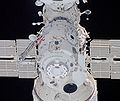Ankopplung (Raumfahrt)
Als Ankopplung wird in der Raumfahrt die Verbindung zweier Raumschiffe oder Module während eines Weltraum-Rendezvous bezeichnet, die sich dazu auf einer fast identischen Bahn befinden müssen. Eine spätere Lösung der Verbindung heißt Abkopplung.
Das selbstständige Ankoppeln eines frei fliegenden Raumschiffs wird auch als Andocken (englisch docking) bezeichnet. Hingegen wird das Ankoppeln mit Hilfe eines Roboterarms als Anlegen (englisch berthing) bezeichnet.
Allgemeines
Der Zweck der Ankopplung kann ein rein technischer sein (gemeinsame Stromversorgung, Datenaustausch usw.) oder (in der bemannten Raumfahrt), um der Besatzung den Überstieg in ein anderes Modul oder in eine Raumstation zu ermöglichen. Die bisher benutzten Module, zum Beispiel die Module der Raumstation Mir dienten unter anderem zur Himmels- und Erdbeobachtung und für biologische, technische oder physikalische Experimente.
Für den Überstieg einer Mannschaft muss der Verbindungskanal völlig luftdicht sein und eine lichte Weite von mindestens 70 cm aufweisen, bekleidet mit einem Raumanzug etwa 100 cm. Nach dem Raketenstart zum Besatzungswechsel auf der Internationalen Raumstation erfolgt die Ankopplung innerhalb von zwei Tagen, nach dem neuen Regime schon nach 6 Stunden.
Damit zwei Raumfahrzeuge aneinander koppeln können, müssen ihre Umlaufbahnen nahezu identisch sein und ihre gegenseitige Geschwindigkeit ein technisch vorgegebenes Limit unterschreiten, das bei empfindlichen Modulen im Bereich einiger Zentimeter pro Sekunde liegt (und dies bei Bahngeschwindigkeiten zwischen 7 und 8 km/s). Die Annäherung der beiden Bahnen erfolgt in der Regel schrittweise, da die einzelnen hierzu nötigen Bahnmanöver nicht mit letzter Genauigkeit möglich sind; dazwischen sind genaue Bahnbestimmungen erforderlich, die zumeist durch terrestrische Bodenstationen unterstützt werden.
Erst in der letzten Annäherungsphase – sobald Sichtkontakt besteht und die Distanzen unter einigen Kilometern liegen – ist eine direkte Ansteuerung durch die Raumfahrer möglich und sinnvoll. Hilfsmittel dafür sind Radar, Dopplereffekt und visuelle Kreuzpeilung. Die vollautomatische Ankopplung wurde von Russland ab etwa 1970 entwickelt und seit etwa 2000 allgemein üblich. Hierfür typische Docking-Relativgeschwindigkeiten sind beziehungsweise waren:
- Space Shuttle: 2 cm/s
- Sojus / Progress: 25 cm/s
- ATV: 7 cm/s
Die erste Ankopplung der Raumfahrt erfolgte am 16. März 1966 durch Gemini 8, gesteuert durch Neil Armstrong und David Scott. Kopplungspartner war das Gemini Agena Target Vehicle, ein unbemannter Zielsatellit.
Die erste automatische Ankopplung wurde von zwei unbemannten Sojus-Raumschiffen durchgeführt: Kosmos 186 und 188 koppelten am 30. Oktober 1967.
Im Juni 1997 führte ein fehlgeschlagenes Ankoppelungsmanöver eines Progress-Raumschiffs mit der Raumstation Mir zur Kollision mit dem Spektr-Modul der Raumstation, welches dabei schwer beschädigt wurde. Dabei war das Leben der damaligen Mir-Besatzung ernsthaft in Gefahr.
Der russische Ingenieur Wladimir Siromjatnikow[1] gilt als Übervater der russischen Dockingmodule.
Sowjetische bzw. russische Kopplungssysteme
Kopplungssystem Kontakt
Für das Mondprogramm wurde ein Kopplungssystem namens Kontakt entwickelt. Es bestand aus einem passiven und einem aktiven Teil. Der aktive Teil am Mondraumschiff Sojus 7K-LOK sollte in eine Platte mit mehreren Löchern am Mondlandemodul LK einhaken. Dieses System kam aber aufgrund der Probleme mit der Mondrakete N1 nie zum Einsatz.[2]
- Kontakt-Kopplungssystem
Kopplungssystem des 7K-OK
Auch dieses System besteht aus einem passiven und einem aktiven Teil. Der passive Teil hat die Form eines Trichters und nimmt den aktiven Teil auf. Dieses System wurde zur Kopplung von Sojus-Raumschiffen untereinander entwickelt. Es koppelte die beteiligten Raumschiffe mechanisch und elektrisch aneinander. Allerdings bestand keine Möglichkeit für die Raumfahrer durch den Kopplungsadapter hindurch die Raumschiffe zu wechseln. Ein Umstieg konnte nur mittels eines Weltraumaustiegs durchgeführt werden. Erstmals kam das System beim Flug der unbemannten Sojus-Raumschiffe Kosmos 186 und 188 zum Einsatz.[2]
- Kopplungssystem des 7K-OK: rechts der aktive und links der passive Part
SSWP
Das Kopplungssystem wurde für die Kopplung der Sojus-Raumschiffe mit den Saljut-Stationen entwickelt und besteht aus einem aktiven und passiven Teil.[3]
- Kopplungssystem seit 7K-T: rechts der aktive und links der passive Part, bis heute im Einsatz
APAS
Das Androgynous Peripheral Attach System (APAS) (russisch АСПП, Агрегат Стыковочный Пассивный Периферийный, Gerät zum passiven peripheren Koppeln) wurde 1975 als APAS-75-System für das Apollo-Sojus-Test-Projekt entwickelt. Teilweise wurden in dem Projekt auch die Bezeichnungen Androgynous Peripheral Assembly System (APAS) und Androgynous Peripheral Docking System (APDS) für die Kopplungstechnik verwendet.
Später entstand daraus auf sowjetischer Seite das APAS-89-System für die Kopplung der Raumfähre Buran an die Raumstation Mir. Mittels eines Adapters konnten auch US-amerikanische Space Shuttles an der Mir an dem System andocken. Für die ISS wurde zur Kopplung der Space Shuttles das System als APAS-95 weiterentwickelt.
- Systemskizze APAS-75 von Sojus 7K-TM
US-amerikanische Kopplungssysteme
Dockingsystem der Apollo
Konzeptionell ähnlich dem System der Sojus bestand das Dockingsystem des Apollo-Raumfahrzeuges aus einem aktiven Teil am Kommandomodul (CM) und einem passiven Teil an der Mondlandefähre (bzw. am MDA im Falle von Skylab). Die Sonde des aktiven Teils wurde, durch eines der beiden Raumschiffe gesteuert, in den Kegel des passiven Teils eingeführt und durch ein Federsystem herangezogen. Am Außendurchmesser rasteten daraufhin zwölf krallenartige Riegel ein und verbanden die Fahrzeuge fest miteinander. Sonde und Kegel mussten anschließend manuell entfernt und gelagert werden. Die Verbindung war einerseits elektrisch durch Entriegelung der Riegel, andererseits pyrotechnisch durch Absprengen der gesamten Dockinghardware (die dann auf der passiven Seite verblieb) trennbar.
- Passiver Teil
- Aktiver Teil von Apollo
- Aktiver Teil von Apollo
- Das Kommando- und Servicemodul (links) kurz vor dem Kontakt mit der Aufstiegsstufe der Apollo-Mondlandefähre (rechts)
Kopplungsstutzen der Internationalen Raumstation (ISS)
Zur Kopplung der Module der ISS kommen dem Zweck entsprechend verschiedene Kopplungsmechanismen zum Einsatz. Es gibt verschiedene Kopplungssysteme für die unter Druck stehenden Teile, wie auch für nicht unter Druck stehende Module oder Geräteträger. Der russische Teil verwendet die schon in der Sowjetunion entwickelten Systeme, der US-amerikanische Teil entsprechend andere. Zur Kopplung der beiden Hauptteile der ISS wird der Pressurized Mating Adapter-1 mit einem passiven Common Berthing Mechanism auf der US- und einem passiven APAS-95-Stutzen auf der russischen Seite eingesetzt.
Mit dem International Docking System Standard wurde von den Partnern der ISS 2010 ein offener Standard für Kopplungsadapter geschaffen, der die Vielfalt der Systeme in der internationalen Raumfahrt reduzieren, bzw. zueinander kompatible Systeme schaffen soll.
APAS-95
Das russische „Androgynous Peripheral Attach System“ (APAS-95) ist die Weiterentwicklung des APAS-89-Systems.[3] Es wird für die Verbindung des russischen Teils mit dem US-amerikanischen Teil der ISS am Pressurized Mating Adapter PMA-1 eingesetzt. Außerdem kam es zum Andocken von Zubringerfahrzeugen an den PMAs 2 und 3 zum Einsatz[4], bevor diese 2016 und 2019 mittels IDA-Adaptern auf den IDSS-Standard umgerüstet wurden.
- APAS-95 im aktiven Betriebsmodus am Space Shuttle
- APAS-95 im passiven Betriebsmodus an PMA-2
SSWP G4000
Dies ist der passive Teil des Sojus-Kopplungssystems und ist an Pirs, Poisk, Rasswet und Swesda zum Koppeln von Sojus, Progress und ATV verbaut.
- Passiver Kopplungsadapter des Sojustyps an Pirs
- Aktiver Kopplungsadapter an dem russischen Raumfrachter Progress
SSWP M8000
Das SSWP M8000 ist ein sogenanntes Hybrid-System, das aus SSWP und APAS für die Kopplung der großen russischen Module entwickelt wurde. Dieses nutzt den Außenring des APAS und das "Trichter-Stangen"-Design des SSWP. Damit hat es einen größeren Durchmesser als das SSWP G4000. Zum Einsatz kommt es zur Kopplung der Module Sarja, Swesda, Pirs und Poisk.
- Pirs-Modul kurz vor dem Andocken an die ISS. Man sieht den aktiven Kopplungsstutzen des Hybrid-Systems, mit dem das Modul an der Station koppelt
CBM
Der US-amerikanische „Common Berthing Mechanism“ (CBM) ist mit 127 cm Durchmesser auch für große Frachtstücke geeignet. Er verbindet die US-amerikanischen Teile der ISS untereinander und wurde zum Andocken mit dem Multi-Purpose Logistics Module verwendet. Jetzt nutzen das japanische HTV-Versorgungsraumschiff, die Dragon und die Cygnus diesen Mechanismus.
- MPLM, Shuttle-Frachtmodul
- HTV, japanisches Versorgungsmodul
- PMA-1, die russisch-amerikanische Verbindungsstelle der ISS
LIDS
Das US-amerikanische Low Impact Docking System (LIDS) war für die Ankopplung des ursprünglich geplanten und 2002 eingestellten X-38 Crew Return Vehicle vorgesehen. Es sollte die nächste Generation des APAS-Kopplungsadapters darstellen.[4] Ursprünglich sollte dann das Crew Exploration Vehicle, aus dem sich später das Orion-Raumschiff entwickelte, mit diesem Adapter versehen werden, um an der ISS andocken zu können.[5] Da die NASA keine Flüge des Orion-Raumschiffs mehr zur ISS plant, wurde dieses Projekt eingestellt. Die Adapterentwicklung fand ihre Fortsetzung im international Low Impact Docking System (iLIDS) bzw. dem NASA Docking System (NDS), die kompatibel zum IDSS-Standard gestaltet wurden.
- Low-Impact Docking System
- PMA-2 und PMA-3 mit Adapterringen
IBDM
Der International Berthing and Docking Mechanism (IBDM) wird unter der Regie der ESA entwickelt. Anfang 2016 wurde bekanntgegeben, dass die ESA den ersten Andockadapter für den Dream Chaser beistellen wird.[6] Der IBDM ist kompatibel zum IDSS-Standard.
NDS
NDS, das NASA Docking System ist die praktische Umsetzung der NASA für den IDSS-Standard. Das NDS wurde erstmals an den IDA-Adaptern ausgeführt. Diese verfügen auf der Raumstationsseite über einen APAS-95-Andockstutzen und wurden auf die beiden freien PMAs gesetzt. IDA1 ging 2015 beim Start verloren. IDA2 wurde 2016 und IDA3 2019 zur ISS gebracht und montiert. 2019 dockte erstmals ein Raumschiff, eine Dragon V2, dort an. Auch die neuen Raumschiffe CST-100 Starliner und Dream Chaser sollen an den NDS-Stutzen anlegen.
SSAS
Das Segment to Segment Attachment System (SSAS) verbindet Teile der Integrated Truss Structure: S0 mit S1, S1 mit S3, sowie S0 mit P1 und P1 mit P3.
RTAS
Das Rocketdyne Truss Attachment System (RTAS) verband Z1 mit P6 während des Aufbaus der Station. Nach der Fertigstellung verbindet das RTAS P6 mit P5 und S6 mit S5.
MRTAS
Das Modified Rocketdyne Truss Attachment System (MRTAS) besteht je aus einem passiven und aktiven Teil und verbindet P5 mit P4 und S5 mit S4.
Siehe auch
- Zur Theorie der Bahnübergänge siehe Himmelsmechanik und Übergangsbahn.
Literatur
- Albert Ducrocq: Sieg über den Raum, rororo 1961
- Richard Heinrich Giese: Raumfahrttechnik Band I, Bibliogr.Institut, Mannheim 1966
- R. Wallisfurth, Rußlands Weg zum Mond. Econ-Verlag, Wien-Düsseldorf 1964
- Wigbert Fehse: Handbook Automated Rendezvous and Docking of Spacecraft. Cambridge University Press, 2008 (Online-Information)
Weblinks
Quellen
- ↑ James Oberg: When two spacecraft meet, they rely on Vladimir Syromyatnikov. IEEE Spectrum, 1. April 2006, abgerufen am 29. Juni 2013 (englisch).
- ↑ a b David S. F. Portree: MIR Hardware Heritage. (PDF; 4 MB) NASA, 1995, abgerufen am 26. März 2023 (englisch).
- ↑ a b Anatoly Zak: Docking systems. In: RussianSpaceWeb. 2. Mai 2023, abgerufen am 22. August 2023 (englisch).
- ↑ a b ISS Interface Mechanisms and their Heritage. (PDF; 3 MB) NASA, abgerufen am 4. November 2011 (englisch).
- ↑ NASA: NASA's Exploration Systems Architecture Study. (PDF) November 2005, S. 38 (Seite 44 im PDF), abgerufen am 4. April 2023 (englisch): „It is recommended that the CEV utilize an androgynous Low-Impact Docking System (LIDS) to mate with other exploration elements and the ISS.“
- ↑ Europe to invest in Sierra Nevada’s Dream Chaser cargo vehicle. SpaceNews.com, 22. Januar 2016, abgerufen am 27. Dezember 2018 (englisch).
Auf dieser Seite verwendete Medien
A blanket of heavy cloud cover forms the backdrop for this image featuring the Italian-built Raffaello Multi-Purpose Logistics Module (MPLM) and the Canadarm2 of the International Space Station. This image was photographed by astronaut Stephen K. Robinson (out of frame), STS-114 mission specialist, during today’s session of extravehicular activity (EVA)
Image of the active portion of the U.S. probe and drogue docking system taken during Apollo 17.
Apollo Docking Mechanism The Lunar Module docking with the Comand/Service Module.
S122-E-006381: Backdropped by the blackness of space and Earth's horizon, Atlantis' orbiter docking system (foreground) and the Canadarm Remote Manipulator System (RMS) in the payload bay are featured in this image photographed by a STS-122 crewmember during flight day two activities. Image has been cropped and rotated.
The Pressurized Mating Adapter-1 (PMA-1), scheduled to fly on Space Shuttle mission STS-88 is undergoing processing in the Space Station Processing Facility (SSPF). A PMA is a cone-shaped connector that will be attached to Node 1, the space station's structural building block, during ground processing. STS-88 is the first International Space Station assembly flight.
The Russian Docking Compartment, named Pirs (the Russian word for pier), is only seconds away from docking with the International Space Station (ISS). One of the Expedition Three crew members, using a digital still camera with a 35mm lens, recorded the image from onboard the orbital outpost. The vehicle was launched on September 14, 2001 and docking occurred on September 16.
Prior to the docking of the Space Shuttle Endeavour to the International Space Station (ISS), a STS-108 crewmember photographed the Androgynous Peripheral Attachment System (APAS) docking area of Pressurized Mating Adapter 2 (PMA2). Once docked, the STS-108 crew can deliver necessary supplies and the Expedition Four crew can replace the Expedition Three crew as long term residents of the ISS. This image was taken with a digital still camera.
None.
ISS023-E-030584 (1 May 2010) --- An unpiloted ISS Progress resupply vehicle approaches the International Space Station, bringing 2.6 tons of food, fuel, oxygen, propellant and supplies for the Expedition 23 crew members aboard the station. Progress 37 docked to the Pirs Docking Compartment at 2:30 p.m. (EDT) on May 1, 2010, after a three-day flight from the Baikonur Cosmodrome in Kazakhstan. The docking was conducted by Russian cosmonaut Oleg Kotov, commander, in manual control through the TORU (telerobotically operated) rendezvous system due to a jet failure on the Progress that forced a shutdown of the Kurs automated rendezvous system.
A Progress supply ship linked up to the orbiting International Space Station (ISS) at 3:48 GMT, November 18, bringing Expedition 1 commander William M. Shepherd, pilot Yuri P.
Gidzenko and flight engineer Sergei K. Krikalev two tons of food, clothing, hardware and holiday gifts from their families. The photograph was taken with a 35mm camera and the film was later handed over to the STS-97 crew members
for return to Earth and subsequent processing.Kontakt docking system. Never used in space, the system was designed for the Soviet lunar program. The Aktiv unit (top) was located at the front of the L2, while the passive unit was located on top of the L3 lander.
ISS031-E-070804 (25 May 2012) --- The SpaceX Dragon commercial cargo craft is grappled by the Canadarm2 robotic arm at the International Space Station. Expedition 31 Flight Engineers Don Pettit and Andre Kuipers grappled Dragon at 9:56 a.m. (EDT) and used the robotic arm to berth Dragon to the Earth-facing side of the station's Harmony node at 12:02 p.m. May 25, 2012. Dragon became the first commercially developed space vehicle to be launched to the station to join Russian, European and Japanese resupply craft that service the complex while restoring a U.S. capability to deliver cargo to the orbital laboratory. Dragon is scheduled to spend about a week docked with the station before returning to Earth on May 31 for retrieval.
View of APAS to NDS docking adapters.
The Low-Impact Docking System, better knows as LIDS, is a prototype of a docking system that may be used on future spaceships. LIDs eliminates the high forces associated with docking, is compatible with berthing operations and is easily reconfigurable to support a wide range of vehicles and mating operations. James Lewis, project manager, is shown with the LIDS prototype.
Original Soyuz probe and drogue docking system. The active unit (right) consisted of a probe and latches; the passive unit, a receiving cone, socket, and catches. The passive unit’s frustum was longer than the active unit’s because it was designed to accept the probe. The probe acted as a shock absorber. Its tip contained sensors which registered contact with the cone, disabled the active craft’s control system, and fired thrusters on the active craft to force the spacecraft together. The probe entered the socket at the apex of the cone, whereupon catches and a restraining ring locked it into place. Plugs and sockets in the rims of the docking units then established electrical and intercom connections between the spacecraft.
- Pirs docking module taken by STS-108 (NASA)
- original description: Backdropped by the blackness of space, the Pirs docking compartment on the International Space Station (ISS) was photographed by a crew member aboard the Space Shuttle Endeavour.
APAS-89 androgynous docking unit.
Apollo docking system probe (drawing)
Soyuz internal transfer docking unit. This system is used today for docking spacecraft to Mir. The active craft inserts its probe into the space station receiving cone. The probe tip catches on latches in the socket at the apex of the cone. Motors then draw the two spacecraft together. Latches in the docking collars catch, and motors close them. Fluid, gas, and electrical connections are established through the collars. After the cosmonauts are certain the seal is airtight, they remove the probe and drogue units, forming a tunnel between spacecraft and station. At undocking, four spring push rods drive the spacecraft apart. If the latches fail to retract, the spacecraft can fire
pyrotechnic bolts to detach from the station.APAS-75 docking unit. Unlike previous docking systems, both units could assume the active or passive roles as required. For docking, the spade-shaped guides of the extended active unit (right) and the retracted passive unit (left) interacted for gross alignment. The ring holding the guides shifted to align the active unit latches with the passive unit catches. After these caught, shock absorbers dissipated residual impact energy in the American unit; mechanical attenuators served the same function on the Soviet side. The active unit then retracted to bring the docking collars together. Guides and sockets in the docking collars completed alignment. Four spring push rods drove the spacecraft apart at undocking. The passive craft could play a modified active role in undocking if the active craft could not complete the standard undocking procedure. Pyrotechnic bolts provided backup.
Backdropped by the thin line of Earth's atmosphere and the blackness of space, the International Space Station's Canadarm2 unberths the unpiloted Japanese H-II Transfer Vehicle (HTV) in preparation for its release from the station. European Space Agency astronaut Frank De Winne, Expedition 21 commander; NASA astronaut Nicole Stott and Canadian Space Agency astronaut Robert Thirsk, both flight engineers, used the station's robotic arm to grab the HTV cargo craft, filled with trash and unneeded items, and unberth it from the Harmony node's nadir port. The HTV was successfully unberthed at 10:18 a.m. (CDT) on Oct. 30, 2009, and released from the station's Canadarm2 at 12:32 p.m.







































